Detailed Report on Site Layout and Short-Term Planning in Construction
VerifiedAdded on 2023/06/03
|8
|1804
|324
Report
AI Summary
This report provides a detailed analysis of site layout and short-term planning for a construction project involving two five-story student accommodation blocks. It includes a list of essential items for the site layout, a scaled site layout plan, and a description of access to and around the site, emphasi...
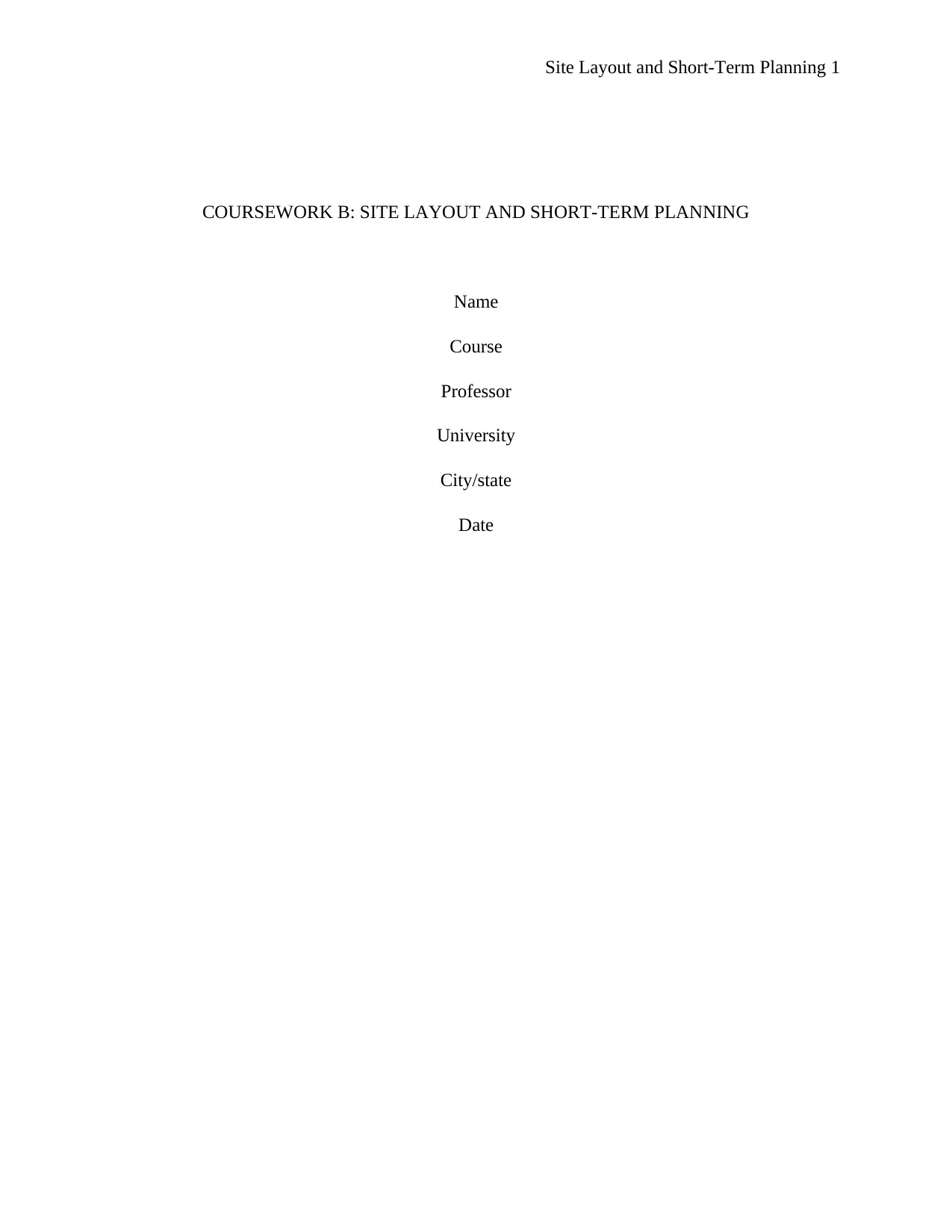
Site Layout and Short-Term Planning 1
COURSEWORK B: SITE LAYOUT AND SHORT-TERM PLANNING
Name
Course
Professor
University
City/state
Date
COURSEWORK B: SITE LAYOUT AND SHORT-TERM PLANNING
Name
Course
Professor
University
City/state
Date
Paraphrase This Document
Need a fresh take? Get an instant paraphrase of this document with our AI Paraphraser
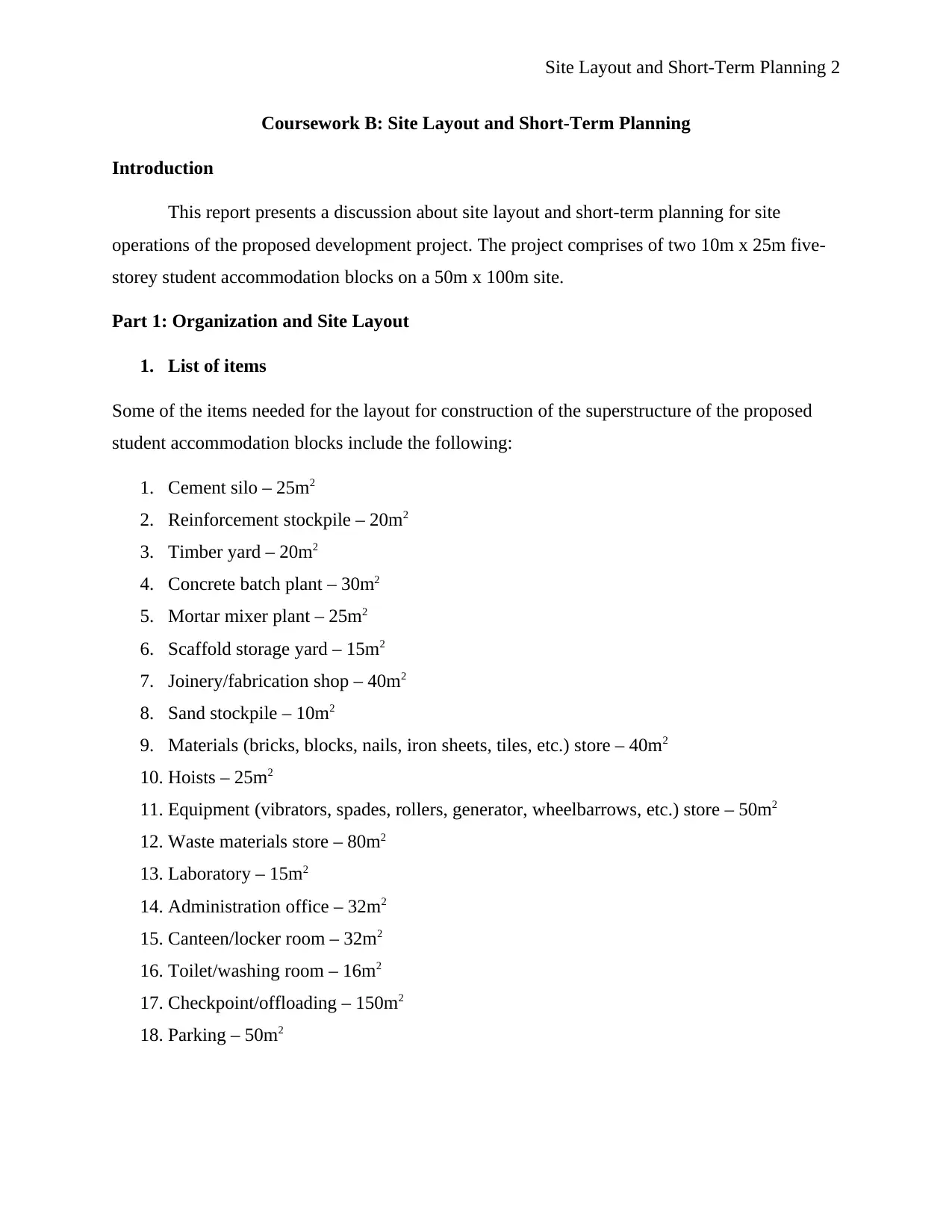
Site Layout and Short-Term Planning 2
Coursework B: Site Layout and Short-Term Planning
Introduction
This report presents a discussion about site layout and short-term planning for site
operations of the proposed development project. The project comprises of two 10m x 25m five-
storey student accommodation blocks on a 50m x 100m site.
Part 1: Organization and Site Layout
1. List of items
Some of the items needed for the layout for construction of the superstructure of the proposed
student accommodation blocks include the following:
1. Cement silo – 25m2
2. Reinforcement stockpile – 20m2
3. Timber yard – 20m2
4. Concrete batch plant – 30m2
5. Mortar mixer plant – 25m2
6. Scaffold storage yard – 15m2
7. Joinery/fabrication shop – 40m2
8. Sand stockpile – 10m2
9. Materials (bricks, blocks, nails, iron sheets, tiles, etc.) store – 40m2
10. Hoists – 25m2
11. Equipment (vibrators, spades, rollers, generator, wheelbarrows, etc.) store – 50m2
12. Waste materials store – 80m2
13. Laboratory – 15m2
14. Administration office – 32m2
15. Canteen/locker room – 32m2
16. Toilet/washing room – 16m2
17. Checkpoint/offloading – 150m2
18. Parking – 50m2
Coursework B: Site Layout and Short-Term Planning
Introduction
This report presents a discussion about site layout and short-term planning for site
operations of the proposed development project. The project comprises of two 10m x 25m five-
storey student accommodation blocks on a 50m x 100m site.
Part 1: Organization and Site Layout
1. List of items
Some of the items needed for the layout for construction of the superstructure of the proposed
student accommodation blocks include the following:
1. Cement silo – 25m2
2. Reinforcement stockpile – 20m2
3. Timber yard – 20m2
4. Concrete batch plant – 30m2
5. Mortar mixer plant – 25m2
6. Scaffold storage yard – 15m2
7. Joinery/fabrication shop – 40m2
8. Sand stockpile – 10m2
9. Materials (bricks, blocks, nails, iron sheets, tiles, etc.) store – 40m2
10. Hoists – 25m2
11. Equipment (vibrators, spades, rollers, generator, wheelbarrows, etc.) store – 50m2
12. Waste materials store – 80m2
13. Laboratory – 15m2
14. Administration office – 32m2
15. Canteen/locker room – 32m2
16. Toilet/washing room – 16m2
17. Checkpoint/offloading – 150m2
18. Parking – 50m2
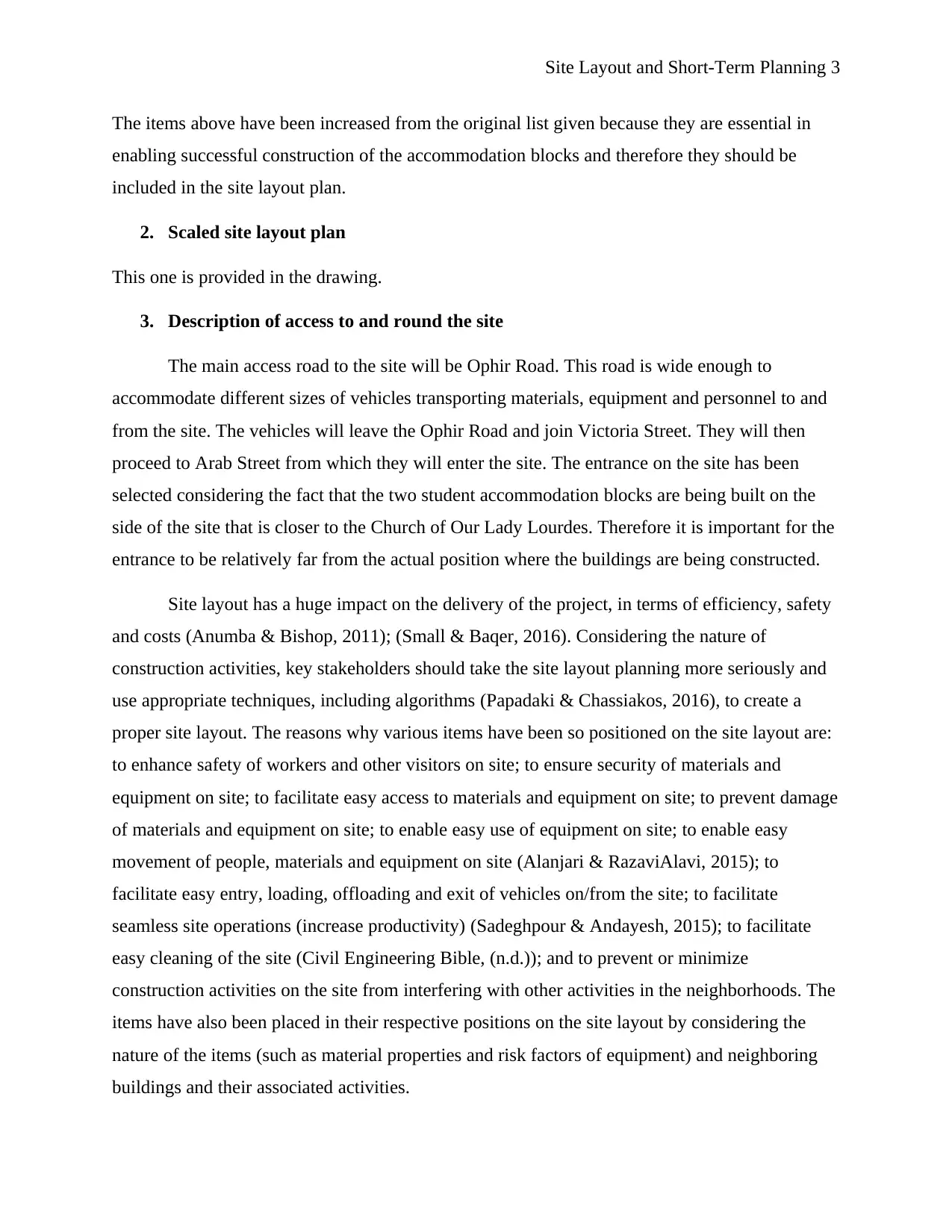
Site Layout and Short-Term Planning 3
The items above have been increased from the original list given because they are essential in
enabling successful construction of the accommodation blocks and therefore they should be
included in the site layout plan.
2. Scaled site layout plan
This one is provided in the drawing.
3. Description of access to and round the site
The main access road to the site will be Ophir Road. This road is wide enough to
accommodate different sizes of vehicles transporting materials, equipment and personnel to and
from the site. The vehicles will leave the Ophir Road and join Victoria Street. They will then
proceed to Arab Street from which they will enter the site. The entrance on the site has been
selected considering the fact that the two student accommodation blocks are being built on the
side of the site that is closer to the Church of Our Lady Lourdes. Therefore it is important for the
entrance to be relatively far from the actual position where the buildings are being constructed.
Site layout has a huge impact on the delivery of the project, in terms of efficiency, safety
and costs (Anumba & Bishop, 2011); (Small & Baqer, 2016). Considering the nature of
construction activities, key stakeholders should take the site layout planning more seriously and
use appropriate techniques, including algorithms (Papadaki & Chassiakos, 2016), to create a
proper site layout. The reasons why various items have been so positioned on the site layout are:
to enhance safety of workers and other visitors on site; to ensure security of materials and
equipment on site; to facilitate easy access to materials and equipment on site; to prevent damage
of materials and equipment on site; to enable easy use of equipment on site; to enable easy
movement of people, materials and equipment on site (Alanjari & RazaviAlavi, 2015); to
facilitate easy entry, loading, offloading and exit of vehicles on/from the site; to facilitate
seamless site operations (increase productivity) (Sadeghpour & Andayesh, 2015); to facilitate
easy cleaning of the site (Civil Engineering Bible, (n.d.)); and to prevent or minimize
construction activities on the site from interfering with other activities in the neighborhoods. The
items have also been placed in their respective positions on the site layout by considering the
nature of the items (such as material properties and risk factors of equipment) and neighboring
buildings and their associated activities.
The items above have been increased from the original list given because they are essential in
enabling successful construction of the accommodation blocks and therefore they should be
included in the site layout plan.
2. Scaled site layout plan
This one is provided in the drawing.
3. Description of access to and round the site
The main access road to the site will be Ophir Road. This road is wide enough to
accommodate different sizes of vehicles transporting materials, equipment and personnel to and
from the site. The vehicles will leave the Ophir Road and join Victoria Street. They will then
proceed to Arab Street from which they will enter the site. The entrance on the site has been
selected considering the fact that the two student accommodation blocks are being built on the
side of the site that is closer to the Church of Our Lady Lourdes. Therefore it is important for the
entrance to be relatively far from the actual position where the buildings are being constructed.
Site layout has a huge impact on the delivery of the project, in terms of efficiency, safety
and costs (Anumba & Bishop, 2011); (Small & Baqer, 2016). Considering the nature of
construction activities, key stakeholders should take the site layout planning more seriously and
use appropriate techniques, including algorithms (Papadaki & Chassiakos, 2016), to create a
proper site layout. The reasons why various items have been so positioned on the site layout are:
to enhance safety of workers and other visitors on site; to ensure security of materials and
equipment on site; to facilitate easy access to materials and equipment on site; to prevent damage
of materials and equipment on site; to enable easy use of equipment on site; to enable easy
movement of people, materials and equipment on site (Alanjari & RazaviAlavi, 2015); to
facilitate easy entry, loading, offloading and exit of vehicles on/from the site; to facilitate
seamless site operations (increase productivity) (Sadeghpour & Andayesh, 2015); to facilitate
easy cleaning of the site (Civil Engineering Bible, (n.d.)); and to prevent or minimize
construction activities on the site from interfering with other activities in the neighborhoods. The
items have also been placed in their respective positions on the site layout by considering the
nature of the items (such as material properties and risk factors of equipment) and neighboring
buildings and their associated activities.
⊘ This is a preview!⊘
Do you want full access?
Subscribe today to unlock all pages.

Trusted by 1+ million students worldwide
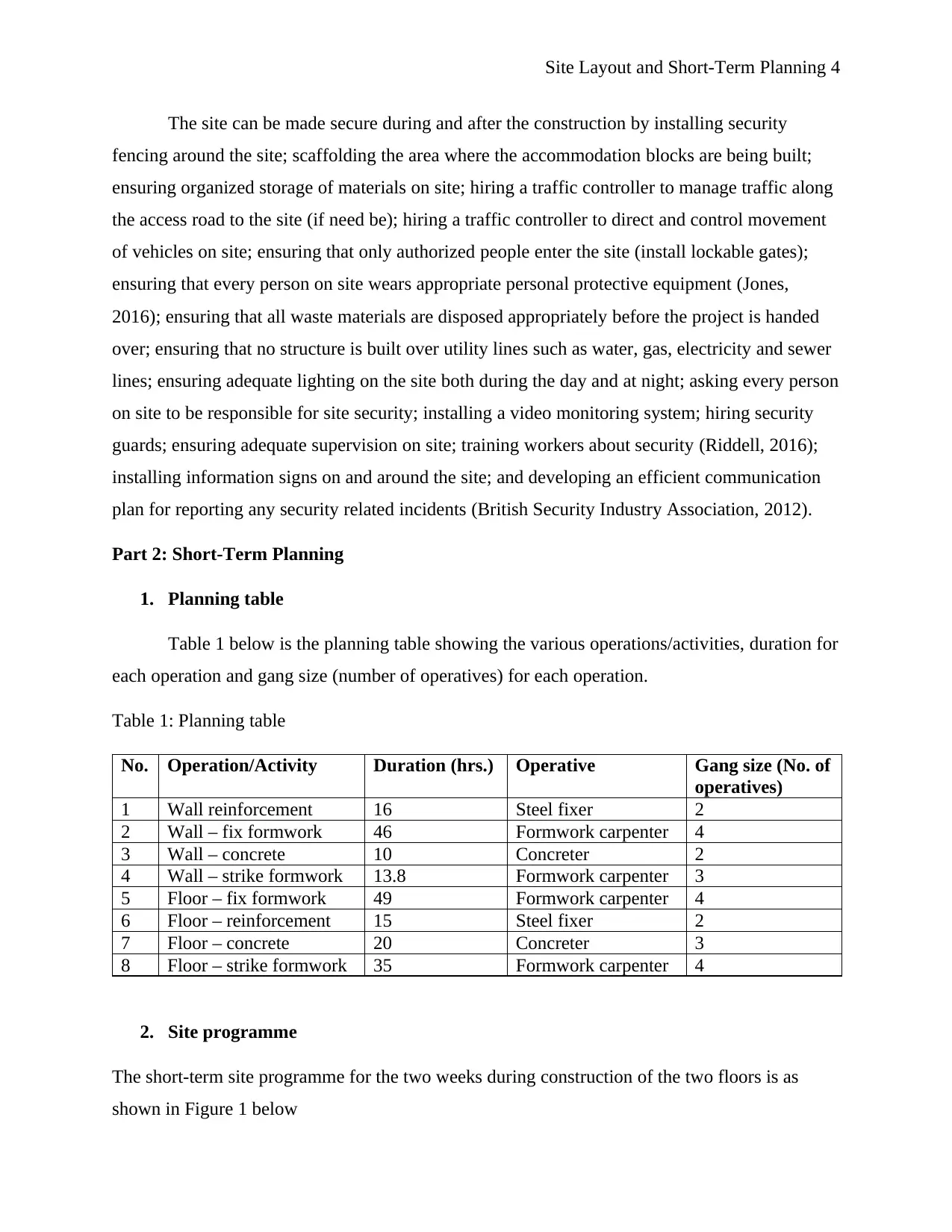
Site Layout and Short-Term Planning 4
The site can be made secure during and after the construction by installing security
fencing around the site; scaffolding the area where the accommodation blocks are being built;
ensuring organized storage of materials on site; hiring a traffic controller to manage traffic along
the access road to the site (if need be); hiring a traffic controller to direct and control movement
of vehicles on site; ensuring that only authorized people enter the site (install lockable gates);
ensuring that every person on site wears appropriate personal protective equipment (Jones,
2016); ensuring that all waste materials are disposed appropriately before the project is handed
over; ensuring that no structure is built over utility lines such as water, gas, electricity and sewer
lines; ensuring adequate lighting on the site both during the day and at night; asking every person
on site to be responsible for site security; installing a video monitoring system; hiring security
guards; ensuring adequate supervision on site; training workers about security (Riddell, 2016);
installing information signs on and around the site; and developing an efficient communication
plan for reporting any security related incidents (British Security Industry Association, 2012).
Part 2: Short-Term Planning
1. Planning table
Table 1 below is the planning table showing the various operations/activities, duration for
each operation and gang size (number of operatives) for each operation.
Table 1: Planning table
No. Operation/Activity Duration (hrs.) Operative Gang size (No. of
operatives)
1 Wall reinforcement 16 Steel fixer 2
2 Wall – fix formwork 46 Formwork carpenter 4
3 Wall – concrete 10 Concreter 2
4 Wall – strike formwork 13.8 Formwork carpenter 3
5 Floor – fix formwork 49 Formwork carpenter 4
6 Floor – reinforcement 15 Steel fixer 2
7 Floor – concrete 20 Concreter 3
8 Floor – strike formwork 35 Formwork carpenter 4
2. Site programme
The short-term site programme for the two weeks during construction of the two floors is as
shown in Figure 1 below
The site can be made secure during and after the construction by installing security
fencing around the site; scaffolding the area where the accommodation blocks are being built;
ensuring organized storage of materials on site; hiring a traffic controller to manage traffic along
the access road to the site (if need be); hiring a traffic controller to direct and control movement
of vehicles on site; ensuring that only authorized people enter the site (install lockable gates);
ensuring that every person on site wears appropriate personal protective equipment (Jones,
2016); ensuring that all waste materials are disposed appropriately before the project is handed
over; ensuring that no structure is built over utility lines such as water, gas, electricity and sewer
lines; ensuring adequate lighting on the site both during the day and at night; asking every person
on site to be responsible for site security; installing a video monitoring system; hiring security
guards; ensuring adequate supervision on site; training workers about security (Riddell, 2016);
installing information signs on and around the site; and developing an efficient communication
plan for reporting any security related incidents (British Security Industry Association, 2012).
Part 2: Short-Term Planning
1. Planning table
Table 1 below is the planning table showing the various operations/activities, duration for
each operation and gang size (number of operatives) for each operation.
Table 1: Planning table
No. Operation/Activity Duration (hrs.) Operative Gang size (No. of
operatives)
1 Wall reinforcement 16 Steel fixer 2
2 Wall – fix formwork 46 Formwork carpenter 4
3 Wall – concrete 10 Concreter 2
4 Wall – strike formwork 13.8 Formwork carpenter 3
5 Floor – fix formwork 49 Formwork carpenter 4
6 Floor – reinforcement 15 Steel fixer 2
7 Floor – concrete 20 Concreter 3
8 Floor – strike formwork 35 Formwork carpenter 4
2. Site programme
The short-term site programme for the two weeks during construction of the two floors is as
shown in Figure 1 below
Paraphrase This Document
Need a fresh take? Get an instant paraphrase of this document with our AI Paraphraser
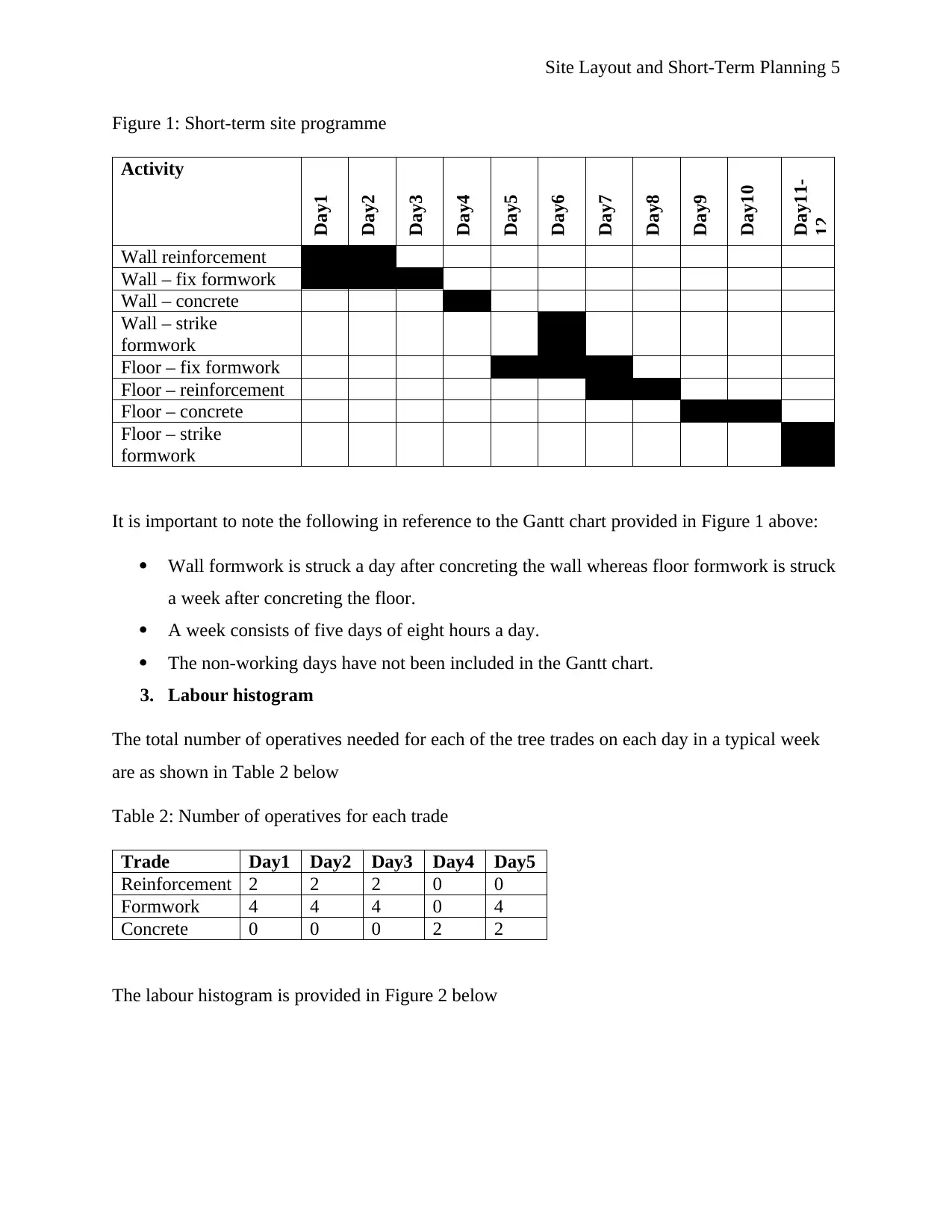
Site Layout and Short-Term Planning 5
Figure 1: Short-term site programme
Activity
Day1
Day2
Day3
Day4
Day5
Day6
Day7
Day8
Day9
Day10
Day11-
12
Wall reinforcement
Wall – fix formwork
Wall – concrete
Wall – strike
formwork
Floor – fix formwork
Floor – reinforcement
Floor – concrete
Floor – strike
formwork
It is important to note the following in reference to the Gantt chart provided in Figure 1 above:
Wall formwork is struck a day after concreting the wall whereas floor formwork is struck
a week after concreting the floor.
A week consists of five days of eight hours a day.
The non-working days have not been included in the Gantt chart.
3. Labour histogram
The total number of operatives needed for each of the tree trades on each day in a typical week
are as shown in Table 2 below
Table 2: Number of operatives for each trade
Trade Day1 Day2 Day3 Day4 Day5
Reinforcement 2 2 2 0 0
Formwork 4 4 4 0 4
Concrete 0 0 0 2 2
The labour histogram is provided in Figure 2 below
Figure 1: Short-term site programme
Activity
Day1
Day2
Day3
Day4
Day5
Day6
Day7
Day8
Day9
Day10
Day11-
12
Wall reinforcement
Wall – fix formwork
Wall – concrete
Wall – strike
formwork
Floor – fix formwork
Floor – reinforcement
Floor – concrete
Floor – strike
formwork
It is important to note the following in reference to the Gantt chart provided in Figure 1 above:
Wall formwork is struck a day after concreting the wall whereas floor formwork is struck
a week after concreting the floor.
A week consists of five days of eight hours a day.
The non-working days have not been included in the Gantt chart.
3. Labour histogram
The total number of operatives needed for each of the tree trades on each day in a typical week
are as shown in Table 2 below
Table 2: Number of operatives for each trade
Trade Day1 Day2 Day3 Day4 Day5
Reinforcement 2 2 2 0 0
Formwork 4 4 4 0 4
Concrete 0 0 0 2 2
The labour histogram is provided in Figure 2 below
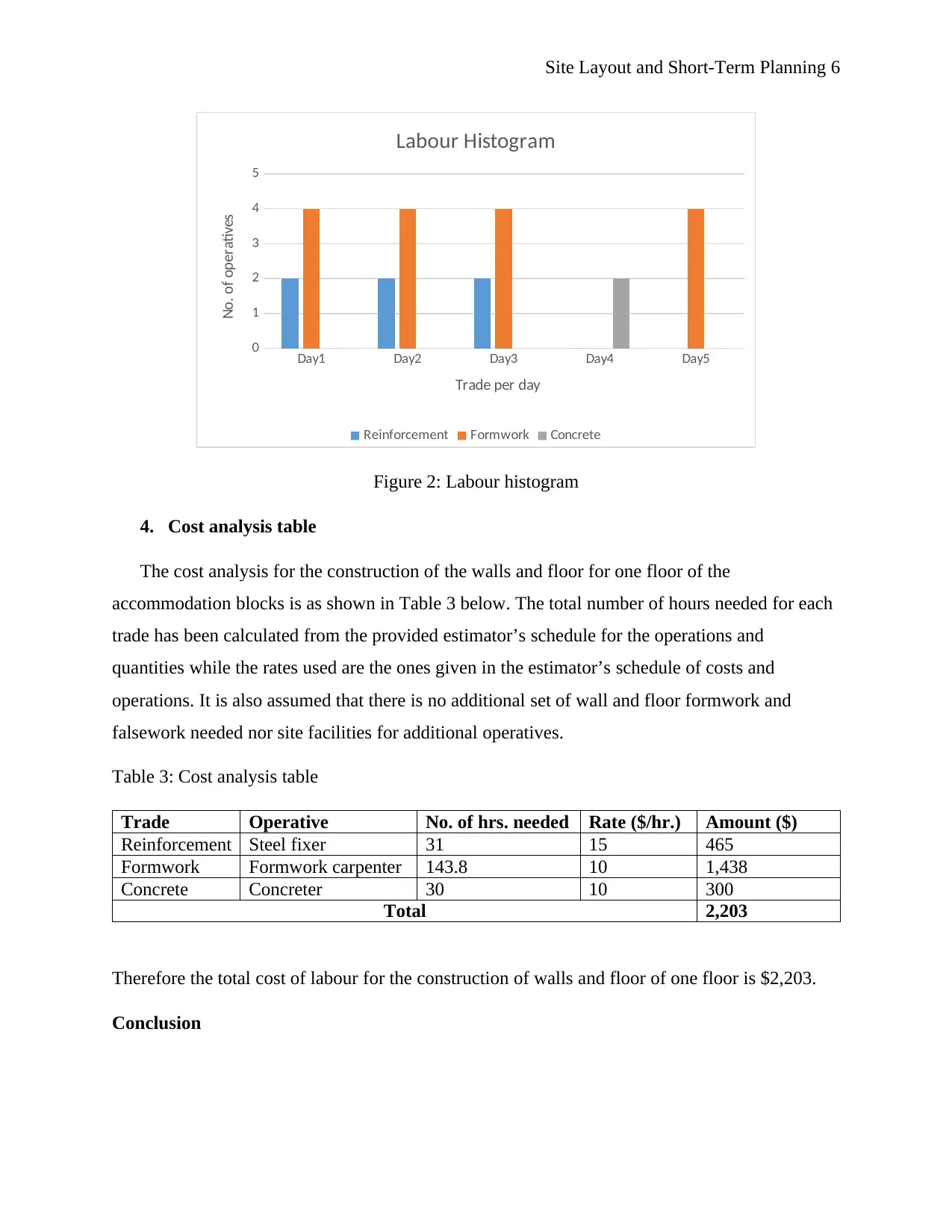
Site Layout and Short-Term Planning 6
Day1 Day2 Day3 Day4 Day5
0
1
2
3
4
5
Labour Histogram
Reinforcement Formwork Concrete
Trade per day
No. of operatives
Figure 2: Labour histogram
4. Cost analysis table
The cost analysis for the construction of the walls and floor for one floor of the
accommodation blocks is as shown in Table 3 below. The total number of hours needed for each
trade has been calculated from the provided estimator’s schedule for the operations and
quantities while the rates used are the ones given in the estimator’s schedule of costs and
operations. It is also assumed that there is no additional set of wall and floor formwork and
falsework needed nor site facilities for additional operatives.
Table 3: Cost analysis table
Trade Operative No. of hrs. needed Rate ($/hr.) Amount ($)
Reinforcement Steel fixer 31 15 465
Formwork Formwork carpenter 143.8 10 1,438
Concrete Concreter 30 10 300
Total 2,203
Therefore the total cost of labour for the construction of walls and floor of one floor is $2,203.
Conclusion
Day1 Day2 Day3 Day4 Day5
0
1
2
3
4
5
Labour Histogram
Reinforcement Formwork Concrete
Trade per day
No. of operatives
Figure 2: Labour histogram
4. Cost analysis table
The cost analysis for the construction of the walls and floor for one floor of the
accommodation blocks is as shown in Table 3 below. The total number of hours needed for each
trade has been calculated from the provided estimator’s schedule for the operations and
quantities while the rates used are the ones given in the estimator’s schedule of costs and
operations. It is also assumed that there is no additional set of wall and floor formwork and
falsework needed nor site facilities for additional operatives.
Table 3: Cost analysis table
Trade Operative No. of hrs. needed Rate ($/hr.) Amount ($)
Reinforcement Steel fixer 31 15 465
Formwork Formwork carpenter 143.8 10 1,438
Concrete Concreter 30 10 300
Total 2,203
Therefore the total cost of labour for the construction of walls and floor of one floor is $2,203.
Conclusion
⊘ This is a preview!⊘
Do you want full access?
Subscribe today to unlock all pages.

Trusted by 1+ million students worldwide

Site Layout and Short-Term Planning 7
The site layout proposed will optimize safer, faster, more efficient and economical
construction operations on the site. Construction of the two floors of the building will take two
weeks and the total labour cost for the construction of walls and floor of one floor is $2,203.
References
The site layout proposed will optimize safer, faster, more efficient and economical
construction operations on the site. Construction of the two floors of the building will take two
weeks and the total labour cost for the construction of walls and floor of one floor is $2,203.
References
Paraphrase This Document
Need a fresh take? Get an instant paraphrase of this document with our AI Paraphraser
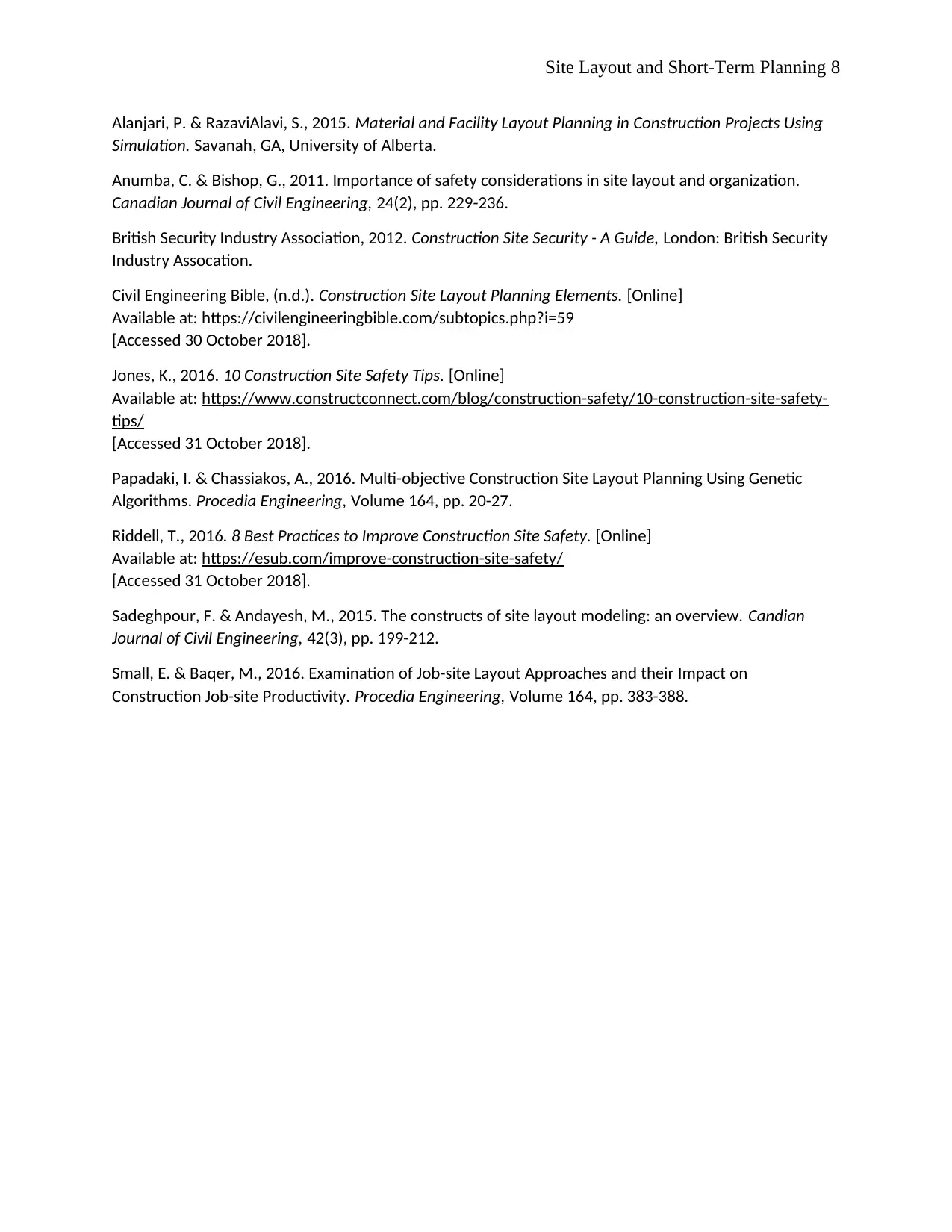
Site Layout and Short-Term Planning 8
Alanjari, P. & RazaviAlavi, S., 2015. Material and Facility Layout Planning in Construction Projects Using
Simulation. Savanah, GA, University of Alberta.
Anumba, C. & Bishop, G., 2011. Importance of safety considerations in site layout and organization.
Canadian Journal of Civil Engineering, 24(2), pp. 229-236.
British Security Industry Association, 2012. Construction Site Security - A Guide, London: British Security
Industry Assocation.
Civil Engineering Bible, (n.d.). Construction Site Layout Planning Elements. [Online]
Available at: https://civilengineeringbible.com/subtopics.php?i=59
[Accessed 30 October 2018].
Jones, K., 2016. 10 Construction Site Safety Tips. [Online]
Available at: https://www.constructconnect.com/blog/construction-safety/10-construction-site-safety-
tips/
[Accessed 31 October 2018].
Papadaki, I. & Chassiakos, A., 2016. Multi-objective Construction Site Layout Planning Using Genetic
Algorithms. Procedia Engineering, Volume 164, pp. 20-27.
Riddell, T., 2016. 8 Best Practices to Improve Construction Site Safety. [Online]
Available at: https://esub.com/improve-construction-site-safety/
[Accessed 31 October 2018].
Sadeghpour, F. & Andayesh, M., 2015. The constructs of site layout modeling: an overview. Candian
Journal of Civil Engineering, 42(3), pp. 199-212.
Small, E. & Baqer, M., 2016. Examination of Job-site Layout Approaches and their Impact on
Construction Job-site Productivity. Procedia Engineering, Volume 164, pp. 383-388.
Alanjari, P. & RazaviAlavi, S., 2015. Material and Facility Layout Planning in Construction Projects Using
Simulation. Savanah, GA, University of Alberta.
Anumba, C. & Bishop, G., 2011. Importance of safety considerations in site layout and organization.
Canadian Journal of Civil Engineering, 24(2), pp. 229-236.
British Security Industry Association, 2012. Construction Site Security - A Guide, London: British Security
Industry Assocation.
Civil Engineering Bible, (n.d.). Construction Site Layout Planning Elements. [Online]
Available at: https://civilengineeringbible.com/subtopics.php?i=59
[Accessed 30 October 2018].
Jones, K., 2016. 10 Construction Site Safety Tips. [Online]
Available at: https://www.constructconnect.com/blog/construction-safety/10-construction-site-safety-
tips/
[Accessed 31 October 2018].
Papadaki, I. & Chassiakos, A., 2016. Multi-objective Construction Site Layout Planning Using Genetic
Algorithms. Procedia Engineering, Volume 164, pp. 20-27.
Riddell, T., 2016. 8 Best Practices to Improve Construction Site Safety. [Online]
Available at: https://esub.com/improve-construction-site-safety/
[Accessed 31 October 2018].
Sadeghpour, F. & Andayesh, M., 2015. The constructs of site layout modeling: an overview. Candian
Journal of Civil Engineering, 42(3), pp. 199-212.
Small, E. & Baqer, M., 2016. Examination of Job-site Layout Approaches and their Impact on
Construction Job-site Productivity. Procedia Engineering, Volume 164, pp. 383-388.
1 out of 8
Your All-in-One AI-Powered Toolkit for Academic Success.
+13062052269
info@desklib.com
Available 24*7 on WhatsApp / Email
![[object Object]](/_next/static/media/star-bottom.7253800d.svg)
Unlock your academic potential
© 2024 | Zucol Services PVT LTD | All rights reserved.